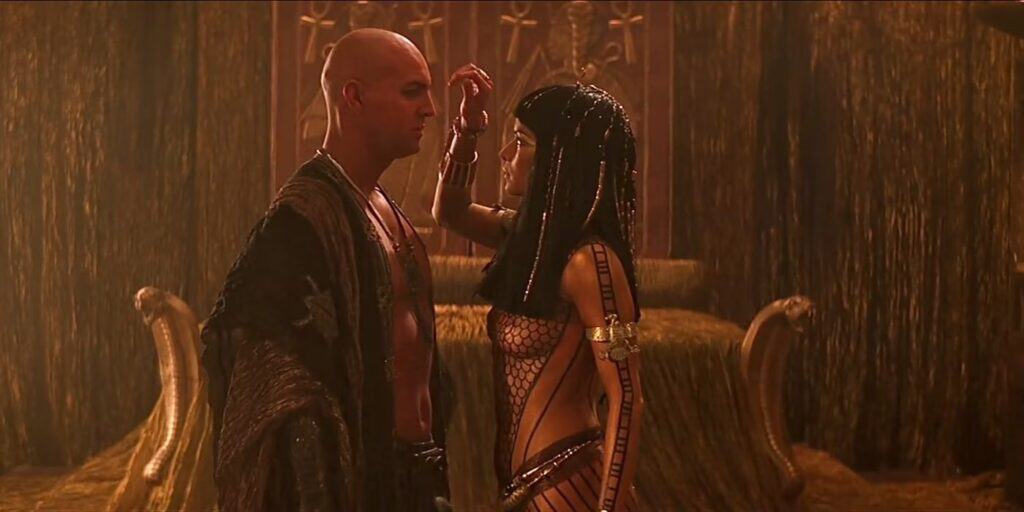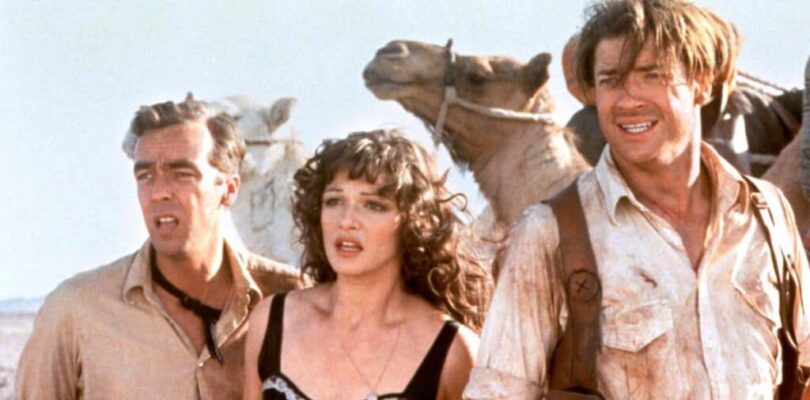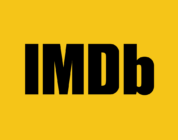From the 1930s into the ‘50s, Universal brought the horror genre some of its greatest icons. Dracula. Frankenstein’s Monster. The Wolf Man. The Creature from the Black Lagoon. The Invisible Man. The Mummy. The studio has returned to these characters multiple times over the decades. But the one that has had the most successful revival was the Mummy, who was brought back to the screen in a family friendly adventure film in 1999. A film that mixed monsters with Indiana Jones style action… and became a blockbuster that’s now seen as a beloved classic. So let’s take a look back at the making of The Mummy ‘99 and find out What the F*ck Happened to This Horror Movie.
To properly cover The Mummy, we first have to flash back to 1922. That’s when the discovery – and the opening – of Egyptian pharaoh Tutankhamun’s tomb captured the world’s imagination. The unearthing of the mummy caught so much attention at the time… and got so many people talking about the tomb being cursed… that it lingered in the minds of Universal executives a decade later. Looking for a good follow-up to the success of Dracula and Frankenstein, producer Carl Laemmle Jr. focused on finding an Egyptian-themed horror story. Story editor Richard Schayer and writer Nina Wilcox Putnam instead delivered a short treatment inspired by Italian occultist Cagliostro, who they envisioned as a three thousand year old magician causing trouble in 1930s San Francisco, terrorizing women who remind him of his ex-lover. Laemmle was satisfied enough with the story to hire John L. Balderston to expand it into a screenplay. And Balderston, who had covered the opening of Tutankhamun’s tomb as a newspaper journalist, was the one who worked in Egyptian elements.
Balderston moved the setting to Egypt and replaced Cagliostro with Egyptian high priest Imhotep. He gave this fellow a tragic back story: thousands of years ago, Imhotep was in love with the princess Ankh-es-en-Amon, who passed away at a young age. The distraught Imhotep tried to use a spell from the Scroll of Thoth to resurrect his lost love. But he was caught and mummified alive for this sacrilege. When his tomb is unearthed by archaeologists in 1921, the Scroll of Thoth is found with him. And when the spell on it is read aloud, Imhotep’s mummy is returned to life. For the next decade, Imhotep passes himself off as a historian named Ardath Bey while searching for Ankh-es-en-Amon’s tomb. Then he meets a young woman who resembles the princess and comes to believe she has been reincarnated. So Imhotep intends to fully bring back Ankh-es-en-Amon by killing, mummifying, and resurrecting her doppelganger.
The 1932 version of The Mummy was a box office success that launched a franchise, but it went dormant in the ‘50s, and Universal didn’t think about reviving it until the late ‘80s. That’s when producers James Jacks and Sean Daniel talked the studio into putting a new take on the concept into development. At first, Universal was only willing to put up a budget of ten to fifteen million dollars, and many filmmakers attempted to come up with an idea that would meet the studio’s approval. As The Mummy made its way through development hell, it passed through the hands of Creepshow director George A. Romero. Hellraiser creator Clive Barker. Frequent Stephen King collaborator Mick Garris. Gremlins director Joe Dante. Screenwriters Abbie Bernstein, Alan Ormsby, and John Sayles. Romero again. Garris again. Some drafts had an unstoppable, Terminator-like mummy seeking an ancient device that can destroy all life on the planet. Another had an Egyptian tomb recreated in modern Beverly Hills. Some were a ‘90s update of the original film that featured not only Imhotep, but also the mummy Kharis, the star of the original sequels. For one reason or another, Universal was never satisfied. For example, they felt Barker’s version was too perverted. And when Dante wanted to raise the budget in hopes of casting Daniel Day-Lewis as Imhotep, that was a no-go. Then the idea came about to make the movie a 1920s period piece, and suddenly Universal decided that it shouldn’t be a low budget horror movie after all. It should be a big budget adventure film.
Tombstone writer Kevin Jarre was hired to write the period piece adventure version of the concept. Jarre did get a story credit on the finished film, alongside Lloyd Fonvielle, who had also written a non-Universal version of The Bride of Frankenstein in the ‘80s. But the final draft of the screenplay was written by Stephen Sommers, who had been a fan of the original Mummy since he first saw it at the age of eight in the early ‘70s. Sommers was aware that Universal had been pushing a new Mummy through development hell for ten years, and he was interested in getting involved, but it always had a different filmmaker attached, so he couldn’t get close to it. Sommers was best known at the time for writing Disney productions like The Adventures of Huck Finn, Tom and Huck, and The Jungle Book, but he also directed a creature feature called Deep Rising that was released in ‘98. When he saw a window of opportunity to get involved with The Mummy as writer/director, he took his pitch to Universal. And they gave him the job.
Sommers told Starlog that he was interested in The Mummy because, “Frankenstein made me sad—I always felt sorry for him. Dracula was kind of cool and sexy. But the Mummy just plain scared me.” As for his vision for the film, he has described it as “a kind of Indiana Jones or Jason and the Argonauts with the Mummy as the creature giving the hero a hard time.” He wanted to take what he loved about the original film and recreate it on a larger scale, while also working in elements from the 1940 film The Mummy’s Hand. And he wanted to bring the world a mummy that was faster, meaner, and scarier than ever before. As he said to Cinefantastique, “I wanted to do an epic, romantic adventure. And I also suggested we had to have Industrial Light and Magic create our Mummy. I didn’t want a guy wrapped in bandages. I wanted to take a real human being and turn him into a corpse, then turn him from a corpse back into a human being.” He was bored with the limitations of practical effects and wanted to dazzle viewers with what CGI could do.
The story Sommers crafted for The Mummy begins three thousand years ago, when Imhotep was high priest to Pharaoh Seti the First… and in love with the Pharaoh’s mistress, Anck-su-namun. When their forbidden love was discovered, they killed Seti. Faced with punishment by the Medjai, the Pharaoh’s bodyguards, Anck-su-namun then killed herself. A minor inconvenience for Imhotep, who can resurrect her with the Book of the Dead. Problem is, he is caught in the middle of the process. He was mummified alive and covered with scarabs… but if his tomb is ever opened, this undead mummy will be released as an invincible being with the power to control the sands. Jump ahead to the 1920s. Treasure hunting thief Jonathan Carnahan and his klutzy librarian sister Evie are seeking the City of the Dead, Hamunaptra, a necropolis that also happened to be the place where the Pharaohs would hide away the wealth of Egypt. So they hire American adventurer Rick O’Connell, who found the city while fighting with the French Foreign Legion years earlier, to lead them there. Another group of fortune hunters, led by Beni Gabor, is also heading to the city. And the Medjai, including Ardeth Bay, try to thwart their progress. No one lets the Medjai deter them. Hamunaptra is located. Imhotep’s tomb is unearthed. He is resurrected and unleashed… and he sets out to resurrect Anck-su-namun by sacrificing Evie. A plan that doesn’t go over well with Evie and Jonathan, or with Rick, who has fallen in love with Evie during their time together.
So Rick does his best to rescue the damsel in distress, kill the bad guy, and save the world. And viewers get to witness comedy-tinged horror action. That involves deadly scarabs, the walking dead, a massive sandstorm, and the ten plagues of Egypt. Water turns to blood, fiery hail falls on Cairo, and those infected with the plague of boils and sores become mindless zombies. Sommers packed so much CGI-enhanced action into his film, Universal had to boost the budget all the way up to eighty million dollars. Fifteen million of that went into the special effects.

Online trivia claims the producers were interested in casting Tom Cruise, Brad Pitt, Matt Damon, or Ben Affleck as Rick O’Connell. Maybe even Sylvester Stallone. But none of those were options as far as Sommers was concerned. While he was still writing the script, his editor Bob Ducsay suggested Brendan Fraser, and the suggestion stuck. Fraser got the offer and accepted it, bringing Rick to life as a man of action who is equal parts tough guy and goofball. The studio was hoping an American actress would be cast as Evie. Ashley Judd was on their wish list. But Sommers felt the character should be British, so Rachel Weisz got the job. John Hannah was cast as her brother Jonathan, with Kevin J. O’Connor as Beni. Sommers had envisioned Ardeth Bay as being an older Black man, someone like James Earl Jones or Roscoe Lee Browne. But that vision changed when he met 20-something Israeli actor Oded Fehr. Patricia Velásquez was cast as Anck-su-namun. Erick Avari and Jonathan Hyde landed supporting roles. The title villain Imhotep was played by Arnold Vosloo, who had previously worked with the producers on the Jean-Claude Van Damme classic Hard Target. While this take on The Mummy has a sense of humor that sometimes leans toward being cartoony, Vosloo’s approach was to play his role entirely straight. He said that, “From Imhotep’s point of view, this is a skewed version of Romeo and Juliet.”
When Imhotep first rises from his tomb, he’s a dried-out corpse… but he regenerates as he kills, sucking the life force out of his victims. Soon enough, it’s Vosloo in the flesh – and he shows so much flesh, the actor had to slim down before filming began.
Some sequences of The Mummy were shot in England, including at Shepperton Studios, where the scenes that take place in the City of the Dead were filmed. It took the construction crew sixteen weeks to put those sets together. A large portion of the production took place in Morocco and out in the Sahara desert – which wasn’t an easy location to deal with. Filming would frequently be shut down by sandstorms that cast and crew had to endure while wearing earplugs and goggles. Some crew members had to be airlifted to medical care after being stung or bitten by the local wildlife. And Sommers admits that they beat the crap out of Brendan Fraser with the stunts and action.
There was a major scare when Fraser performed the scene where Rick is nearly executed by hanging. As Sommers described it to The Hollywood Reporter, “Usually when somebody gets hung, it’s a dummy, and that’s why they put bags over people’s heads. Brendan was always gung-ho, and he was like, ‘Make the noose really tight on me.’ Then he decided to let his knees sag a little bit. But what he forgot is that the minute you put that much pressure on your carotid arteries, it knocks you out. We all looked, and he’s completely unconscious. It was fine, and he recovered in ten seconds. But he woke up like, ‘What happened?’” Thankfully, Fraser came out of it okay. And willing to come back for sequels.

Universal ended up pumping more money into The Mummy than they expected to, but it paid off in the long run. While some horror fans might be put off by the film’s silly sense of humor, it seemed to go over very well with the average movie-goer. Released in May of 1999, Stephen Sommer’s version of The Mummy became a global blockbuster. The title character had been the laughing stock of the Universal Monsters for years. A lot of people would joke about the mummy not being scary, shambling along in his bandages. But while there is some bandage-wrapped mummy action in this movie, that’s not all there is to Imhotep. He is an extremely powerful being – and audiences enjoyed watching Rick O’Connell try to take him down while overcoming everything Imhotep throws his way.
Any one of the filmmakers who were attached to this project before Sommers could have made an interesting, potentially great Mummy movie. But Universal backed Sommers’ vision – and there’s no denying it was a success. The Mummy earned over one hundred and fifty-seven million dollars at the domestic box office, with another two hundred and sixty-one million coming from international screenings, bringing its total haul to just over four hundred and eighteen million. A franchise was born. The sequel The Mummy Returns followed in 2001, and that launched a spin-off franchise with The Scorpion King, which got multiple follow-ups. Another Mummy sequel, The Mummy: Tomb of the Dragon Emperor, came along in 2008… And for a while, Universal was developing a fourth Rick O’Connell mummy adventure that would have been called The Mummy: Rise of the Aztec. But that idea was scrapped in favor of rebooting the franchise with a new film that would kick off a cinematic universe, a series of interconnected Universal Monsters reboots where the monsters would share the screen. The Dark Universe. But that universe fell apart when the 2017 version of The Mummy, which starred Tom Cruise, was a box office disappointment. It actually made about the same amount of money as The Mummy 1999 did. Problem was, the budget was substantially higher.
Other Mummy movies have come and gone since, but The Mummy 1999 wasn’t just a summer hit that then faded away. It has a legion of fans that, over the decades, have come to see it as an enduring classic. People remember having fun seeing it when it was first released. There’s a generation of kids who grew up watching it. For many, this was the gateway movie that got them into the horror genre. And a lot of fans are hoping we’ll get to see Brendan Fraser play Rick O’Connell again, even if it’s just for one more time. That may or may not happen, but in the meantime we can still go back and watch his first Mummy adventure again and again. And while some of the CGI effects look dated now, the movie is still as entertaining as it was in the summer of ‘99.
A couple of the previous episodes of WTF Happened to This Horror Movie? can be seen below. To see more, head over to our JoBlo Horror Originals YouTube channel – and subscribe while you’re there!





